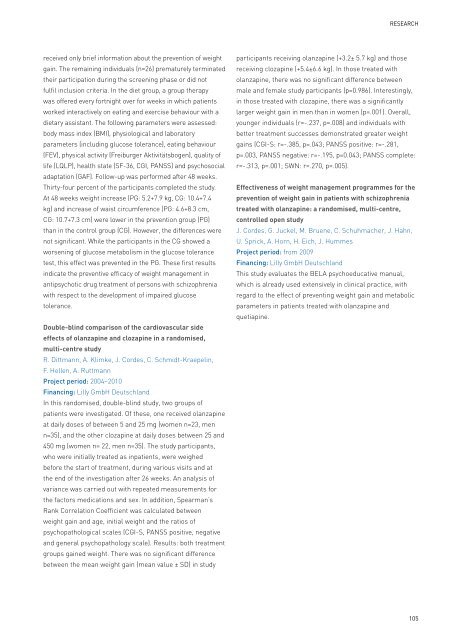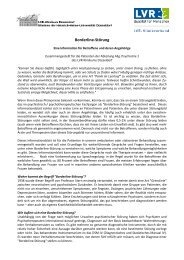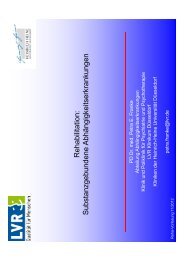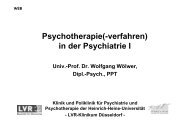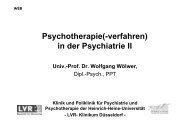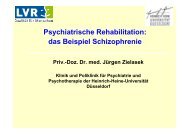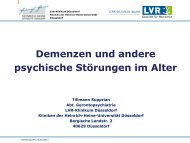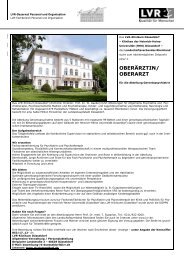LVR-Klinikum Düsseldorf Hospital of the Heinrich-Heine University ...
LVR-Klinikum Düsseldorf Hospital of the Heinrich-Heine University ...
LVR-Klinikum Düsseldorf Hospital of the Heinrich-Heine University ...
Create successful ePaper yourself
Turn your PDF publications into a flip-book with our unique Google optimized e-Paper software.
eceived only brief information about <strong>the</strong> prevention <strong>of</strong> weight<br />
gain. The remaining individuals (n=26) prematurely terminated<br />
<strong>the</strong>ir participation during <strong>the</strong> screening phase or did not<br />
fulfil inclusion criteria. In <strong>the</strong> diet group, a group <strong>the</strong>rapy<br />
was <strong>of</strong>fered every fortnight over for weeks in which patients<br />
worked interactively on eating and exercise behaviour with a<br />
dietary assistant. The following parameters were assessed:<br />
body mass index (BMI), physiological and laboratory<br />
parameters (including glucose tolerance), eating behaviour<br />
(FEV), physical activity (Freiburger Aktivitätsbogen), quality <strong>of</strong><br />
life (LQLP), health state (SF-36, CGI, PANSS) and psychosocial<br />
adaptation (GAF). Follow-up was performed after 48 weeks.<br />
Thirty-four percent <strong>of</strong> <strong>the</strong> participants completed <strong>the</strong> study.<br />
At 48 weeks weight increase (PG: 5.2+7.9 kg, CG: 10.4+7.4<br />
kg) and increase <strong>of</strong> waist circumference (PG: 4.6+8.3 cm,<br />
CG: 10.7+7.3 cm) were lower in <strong>the</strong> prevention group (PG)<br />
than in <strong>the</strong> control group (CG). However, <strong>the</strong> differences were<br />
not significant. While <strong>the</strong> participants in <strong>the</strong> CG showed a<br />
worsening <strong>of</strong> glucose metabolism in <strong>the</strong> glucose tolerance<br />
test, this effect was prevented in <strong>the</strong> PG. These first results<br />
indicate <strong>the</strong> preventive efficacy <strong>of</strong> weight management in<br />
antipsychotic drug treatment <strong>of</strong> persons with schizophrenia<br />
with respect to <strong>the</strong> development <strong>of</strong> impaired glucose<br />
tolerance.<br />
Double-blind comparison <strong>of</strong> <strong>the</strong> cardiovascular side<br />
effects <strong>of</strong> olanzapine and clozapine in a randomised,<br />
multi-centre study<br />
R. Dittmann, A. Klimke, J. Cordes, C. Schmidt-Kraepelin,<br />
F. Hellen, A. Ruttmann<br />
Project period: 2004–2010<br />
Financing: Lilly GmbH Deutschland<br />
In this randomised, double-blind study, two groups <strong>of</strong><br />
patients were investigated. Of <strong>the</strong>se, one received olanzapine<br />
at daily doses <strong>of</strong> between 5 and 25 mg (women n=23, men<br />
n=35), and <strong>the</strong> o<strong>the</strong>r clozapine at daily doses between 25 and<br />
450 mg (women n= 22, men n=35). The study participants,<br />
who were initially treated as inpatients, were weighed<br />
before <strong>the</strong> start <strong>of</strong> treatment, during various visits and at<br />
<strong>the</strong> end <strong>of</strong> <strong>the</strong> investigation after 26 weeks. An analysis <strong>of</strong><br />
variance was carried out with repeated measurements for<br />
<strong>the</strong> factors medications and sex. In addition, Spearman’s<br />
Rank Correlation Coefficient was calculated between<br />
weight gain and age, initial weight and <strong>the</strong> ratios <strong>of</strong><br />
psychopathological scales (CGI-S, PANSS positive, negative<br />
and general psychopathology scale). Results: both treatment<br />
groups gained weight. There was no significant difference<br />
between <strong>the</strong> mean weight gain (mean value ± SD) in study<br />
ReseaRch<br />
participants receiving olanzapine (+3.2± 5.7 kg) and those<br />
receiving clozapine (+5.4±6.6 kg). In those treated with<br />
olanzapine, <strong>the</strong>re was no significant difference between<br />
male and female study participants (p=0.986). Interestingly,<br />
in those treated with clozapine, <strong>the</strong>re was a significantly<br />
larger weight gain in men than in women (p=.001). Overall,<br />
younger individuals (r=-.237, p=.008) and individuals with<br />
better treatment successes demonstrated greater weight<br />
gains (CGI-S: r=-.385, p=.043; PANSS positive: r=-.281,<br />
p=.003, PANSS negative: r=-.195, p=0.043; PANSS complete:<br />
r=-.313, p=.001; SWN: r=.270, p=.005).<br />
Effectiveness <strong>of</strong> weight management programmes for <strong>the</strong><br />
prevention <strong>of</strong> weight gain in patients with schizophrenia<br />
treated with olanzapine: a randomised, multi-centre,<br />
controlled open study<br />
J. Cordes, G. Juckel, M. Bruene, C. Schuhmacher, J. Hahn,<br />
U. Sprick, A. Horn, H. Eich, J. Hummes<br />
Project period: from 2009<br />
Financing: Lilly GmbH Deutschland<br />
This study evaluates <strong>the</strong> BELA psychoeducative manual,<br />
which is already used extensively in clinical practice, with<br />
regard to <strong>the</strong> effect <strong>of</strong> preventing weight gain and metabolic<br />
parameters in patients treated with olanzapine and<br />
quetiapine.<br />
105


